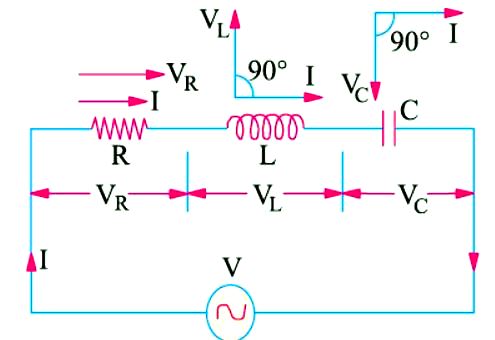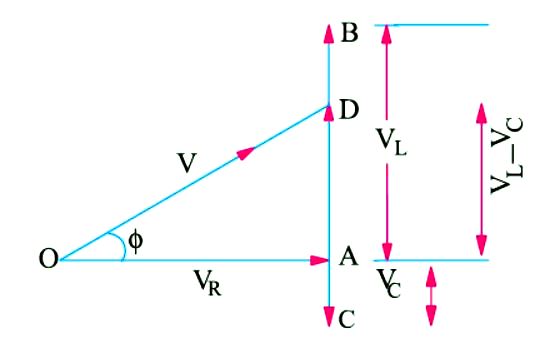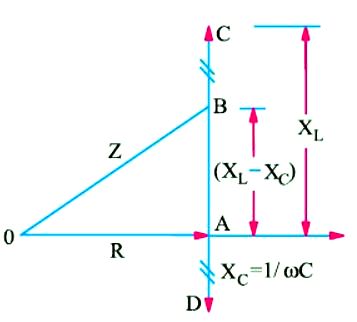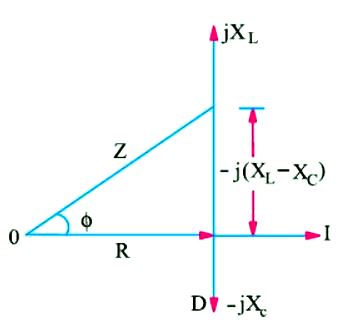Resistance Inductance and Capacitance in Series
The three elements Resistance Inductance and Capacitance in Series are shown in Figure (A) joined in series across an A.C. supply of R.M.S. voltage V.

Let VR = IR = voltage drop across R —in phase with I
VL = I.XL = voltage drop across L —leading I by π/2
VC = I.XC = voltage drop across C —lagging I by π/2
In voltage triangle of Figure (B), OA represents VR, AB and AC represent the inductive and capacitive drops respectively. It will be seen that VL and VC are 180° out of phase with each other i.e. they are in direct opposition to each other.
Subtracting BD (= AC) from AB, we get the net reactive drop AD = I (XL − XC)
The applied voltage V is represented by OD and is the vector sum of OA and AD


(impedance)2 = (resistance)2 + (net reactance)2
or Z2 = R2 + (XL− XC)2 = R2 + X2
where X is the net reactance (Figure (A), (B) & (C)).
Phase angle φ is given by tan φ = (XL − XC)/R = X/R = net reactance/resistance
AdBlock-2

Power factor is ![]()
Hence, it is seen that if the equation of the applied voltage is v = Vmsin ωt, then equation of the resulting current in an R-L-C circuit is given by i = Imsin (ωt ± φ)
The + ve sign is to be used when current leads i.e. XC > XL.
The − ve sign is to be used when current lags i.e. when XL > XC.
In general, the current lags or leads the supply voltage by an angle φ such that tan φ = X/R.
Using symbolic notation, we have (Figure (D)), Z = R + j (XL − XC)
Numerical value of impedance ![]()

Its phase angle is Φ = tan−1 [XL − XC/R]
Z = Z ∠ tan−1[(XL − XC)/R] = Z ∠ tan−1(X/R)
If V = V ∠ 0, then, I = V/Z
Summary of Results of Series AC Circuits
| Type of Impedance | Value of Impedance | Phase angle for current | Power factor |
| Resistance only | R | 0° | 1 |
| Inductance only | ωL | 90° Lag | 0 |
| Capacitance only | 1/ωC | 90° Lead | 0 |
| Resistance and Inductance | 0 < φ < 90° lag | 1 > p.f. > 0 lag | |
| Resistance and Capacitance | 0 < φ < 90° lead | 1 > p.f. > 0 lead | |
| R-L-C | between 0° and 90° lag or lead | between 0 and unity lag or lead |
Read article – R.M.S. voltage
Visit NCERTplanet.com for NCERT solutions and Textbook downloads




